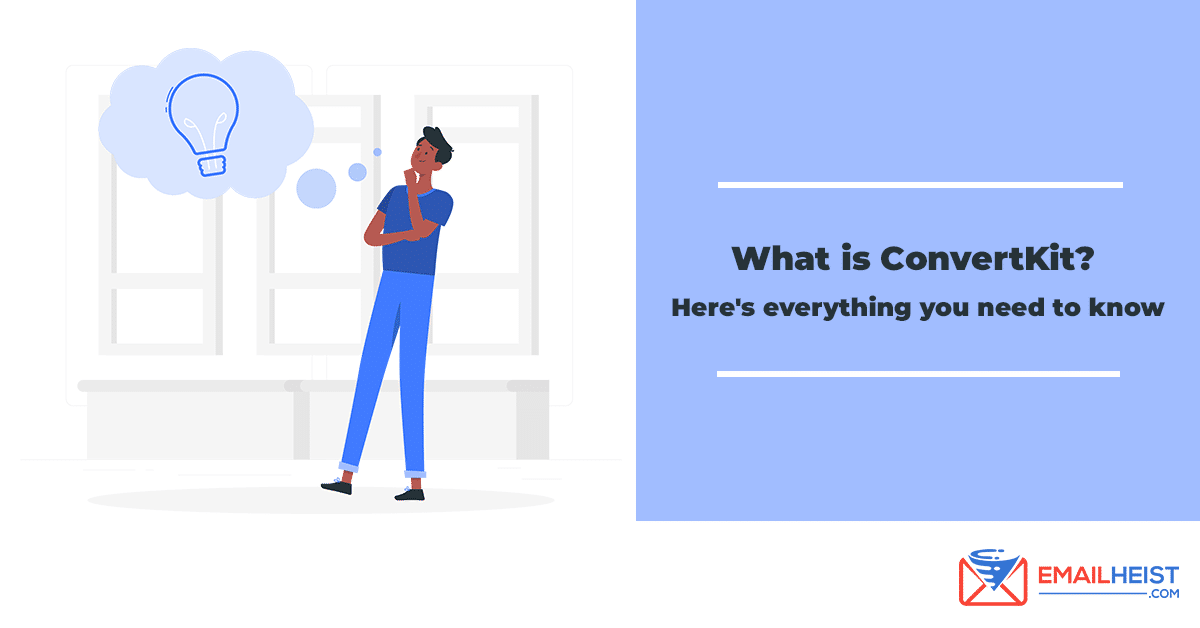What is ConvertKit? Here’s everything you need to know

Email marketing is a tried and tested method, and is still effective up to this day. Instead of losing value over time because of the quick evolution of the internet and the way people consume it, email marketing has adapted and evolved.
Email is a gateway to potential customers and is an opportunity to build relationships and trust with them. An email can convert engagement into profitable sales.
The system that you use for email marketing matters a lot if you’re looking for efficiency. You have to consider automation capabilities, initial setup requirements, the costs, and so much more when trying to look for the right software.
One of the newer email marketing systems out there is ConvertKit, and there is a reason why it outranks the competition in a lot of areas.
This is a comprehensive review of ConvertKit. We detail below why it is something that you should consider.
The birth of ConvertKit
ConvertKit was established in 2013 by Nathan Barry. It was developed out of a desire to sell a product to an audience of his own. The problem was, he didn’t have an audience.
Barry left his job as the head of a software design team for a startup and began working with clients of his who are building iOS apps and writing about it on his newly minted blog.
During this process, he wrote his first eBook titled “The App Design Handbook.” When he launched the book sale to his 798 subscribers at the time, he was able to sell $12,000+ in the first 24 hours.
A few months later, he wrote another book, which he also shared with his subscribers. Though his follower count increased, he still had a relatively small amount of subscribers.
Relying mostly on pre-orders, Barry began to create a digital product for an audience he knew and was part of an email marketing tool that focused on the needs of authors and bloggers who wanted to sell digital products.
It was basic at first, but it grew over time. Every time he came across something his competitors couldn’t do, or how unfriendly for a user their software was, he emerged with new ideas on how he could improve the product he was creating.
He hired Ruby on Rails to build an app, and while he hadn’t hit the $5,000 mark he was expecting in the first six months, he knew he was onto something great.
A year and a half in, a conversation that stopped him in his tracks made him amp up his efforts to go “all in” with ConvertKit.
Barry hadn’t made up much ground in the months since creation. His friend, Hiten Shah, encouraged him to “take ConvertKit seriously and go all in or shut it down.”
Barry noted the conversation with Shah but did nothing for another six months, until he finally came to a crossroads of either having to, in his words.
What is ConvertKit?
ConvertKit is a full-featured email marketing service that offers customizable signup forms and landing pages to help bring in more email subscribers. Thanks to its automation, ease of use, and other features, it’s one of the fastest-growing email marketing companies today.
ConvertKit says it exists to “help creators earn a living online” and prides on its values, which includes “teaching everything they know” to their users and giving value to existing customers more than new customers.
Powerful features of ConvertKit
What makes ConvertKit better than its competitors? Below are some of the powerful features of ConvertKit.
- Landing Pages
ConvertKit offers free landing page templates. They are not only beautiful and completely customizable; you also don’t need a website to host them.
With no code and several options, you can create your landing page quickly and efficiently, so it’s ready to land in front of potential subscribers in no time.
Moreover, they work seamlessly with the signup forms that you can create in-house with ConvertKit.
- Signup Forms
Your subscribers get the first glimpse of what they can expect from you by how they can join your email list seamlessly.
Something as simple as a signup form makes the process of joining your email list very straightforward.
- Visual Automations
When it comes to automation tools, more complex means more complicated. ConvertKit keeps it simple, with easy-to-follow steps so that you can spend your time doing things you want to do, like focus on growing your business. With ConvertKit, you can build easy to set up automated funnels that are user-friendly, yet packed with customizable choices. The best thing about these systems is that you can see everything that is happening for your subscriber, from start to finish.
If you need to edit the content, add a tag, or create a segmentation, you can integrate with one of your favorite tools like WordPress, Zapier, etc.
- Tagging/Segmentation
Tagging your subscribers and segmenting your list into separate parts or sections are some of the best functions of ConvertKit.
Tagging is very simple. If someone does a particular action like joining your list through a specific opt-in, purchases a product, clicks a link within an email, etc., they are labeled with the tag you’ve created.
This comes in handy during the segmentation process. With ConvertKit, you can choose to segment your list or only send a separate email to customers with specific tags. You can choose to send it to “none” with that tag.
- Auto resend broadcasts that are unopened
With other email marketing systems, resending unopened emails can be difficult. However, with ConvertKit, the backend will show you the statistics of who opened, who didn’t, and give you resending options at the click of a button.
You can edit the title and the body of the broadcast, schedule the resend in advance, and have peace of mind knowing that all the automation is taken care of, so you can move onto other things in your business.
- Conditional email content
When somebody greets you by name in person, the conversation feels more personal and connected. It’s also the same with emails.
With ConvertKit, it has a Conditional Content Feature that helps to systemize the personalization like first or last name to your email.
ConvertKit Pricing Plans
The pricing plans of ConvertKit are simple. Apart from the free plan, they offer two paid plans – the Creator Plan and the Creator Pro Plan.
Below are the pricing plans of ConvertKit:
Free Plan
- $0 per month
- Unlimited, customizable CTAs and signup forms
- 30+ premiums landing page templates
- Unlimited traffic
- Customizable domain setup
- Mobile responsive designs
- Seamless Unsplash integration
Creator Plan
- $29 per month for up to 1,000 subscribers
- Unlimited, customizable CTAs and signup forms
- 30+ premium landing page templates
- Unlimited traffic
- Customizable domain setup
- Mobile responsive designs
- Send email broadcasts
- Subscriber tagging
- Sell digital products and subscriptions
- Automated funnels and sequences
- Integrations
- 90+ direct integrations
- API
- Email support
- Creator community
- Premium support
- Free migration from another tool
Creator Pro Plan
- $59 per month for up to 1,000 subscribers
- All of the features available in Creator Plan plus:
- Facebook custom audiences
- Newsletter referral system
- Subscriber scoring
- Advanced reporting
How to get started with ConvertKit
Since creators make ConvertKit for creators, getting started is very easy. Here are the steps that you can follow to begin your journey with ConvertKit.
- Sign up for your ConvertKit account.
At ConvertKit, you only pay for what you need. It offers something for all sizes of subscribers list.
- Create your first form.
You need to make it as easy as possible for people to subscribe to your email list. An essential tool that you need is a signup form. ConvertKit walks you through, step by step, on creating a form to embed on your website, blog, etc.
- Create your first tags and segments.
Now that you’re ready to start assigning tags to your subscribers, you can add. However, you choose your business.
If you are a course creator, you can tag everyone who has joined a particular class or segment them to a list to email those subscribers separately.
Tags and segments can make it easier for you to make sure that your subscribers can get the information they need.
- Import your current email list.
If you already have an email list that you need to move to ConvertKit, make sure to export a CSV list from your current email marketing system.
Once you have done that, simply click on subscribers at the top of the menu, and look for the button that reads, “Import Subscribers.”
After you have dragged and dropped the CSV file, you can add a tag to the list before importing it.
- Send your first email.
Whether it’s an email or newsletter, it’s time to send your first broadcast to your list. With ConvertKit, the system will walk you through setting up a broadcast.
- Create your first funnel.
Don’t be afraid to build your first sequence or automation. You can start with something simple, like your Welcome Sequence.
After creating your first sequence, you can connect it to your opt-in form to start your first automation. ConvertKit makes it simple for its users to create their funnels.
Conclusion
ConvertKit has a lot of strengths. It has quick, friendly and practical support. It is also flexible when managing subscribers through its tagging system, which is something that bloggers can take full advantage of when targeting messages to their audience.
ConvertKit also comes with a landing page editor that allows you to collect subscribers even if you don’t own a website. This is ideal for social media campaigns.
These are some of the things that make ConvertKit stand out. You can try this software to know if it suits your business needs.
Overall, we at Email Heist recommend ConvertKit especially to content creators.
(READ More: GetResponse vs ConvertKit: Which is the better email marketing tool for you?)



One Comment